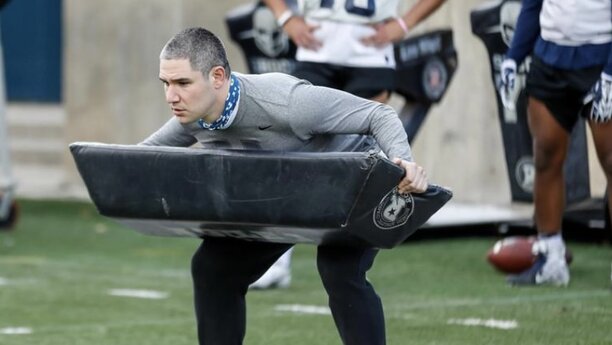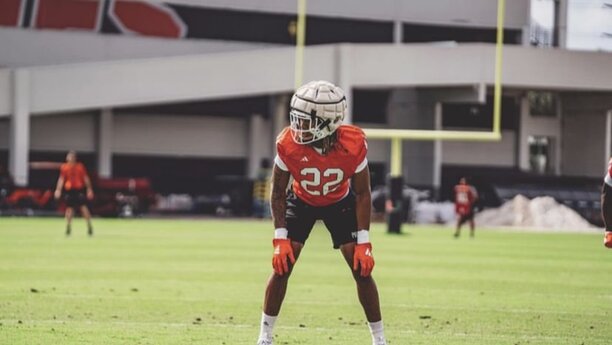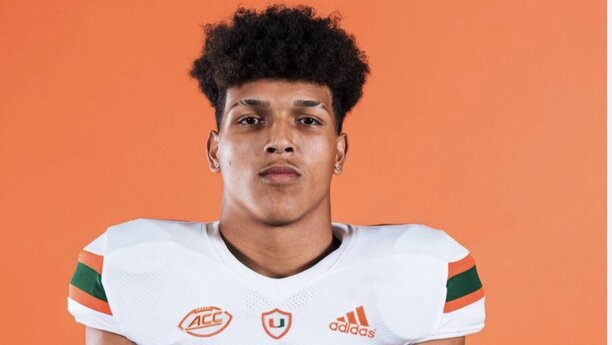Message boards are full of so-called experts who never played or coached the game at the high levels. I’m one of them. CanesInSight is blessed to have Mike Zuckerman, a ten-year college coaching veteran, take us to Football School. He will join the show regularly to provide insight on terms we use every day, but may not fully understand. Zuck, a Miami alum, spent seven years in UM’s football program in various roles and, for the past three years, served as the linebackers coach at Utah State. During his tenure, Utah State had an 11-win season, won the conference, and produced 2023 first-team All-Conference LB MJ Tafisi. Zuck has taken a leave of absence to return to civilian life, which is a blow for Utah State but a blessing for Canes fans.
In this week’s Football School, he talks about the evolution of tackling.
On classic tackling technique: In high school, I was taught to put your head across the ball, shoulder tackle, wrap, drive. No matter what tackling you're teaching, how much can you close the distance to the hit point? If you run through a tackle, that means you close all the distance to the ball carrier and get yourself into a position where you're right next to him and then run your feet through. When you're leaving your feet or stopping your feet with more distance between you and the ball carrier, it's more difficult to make a tackle. We call that “getting to the hit point” in terms of closing that distance.
But everything was always "put your face on the ball."
On rugby tackling: Here are a couple of issues with that and why the rugby tackling started. First of all, when your head's coming across someone's body and they're going forward, that's a collision on your head. I'm a very, very firm believer that if you're a parent trusting me to coach your kid, it's my job to do everything in my power to keep him safe. I truly believe if you're coaching a kid to put his head across the ball, you're setting him up for more concussions. I know there's science and I'm not trying to get into any debates or anything. But it's my job to keep you safe. I need to teach you the safest way possible to tackle. So that's one disadvantage of a classic tackling system.
The other thing is if you put your face across a ball carrier, you're allowing him to cut back opposite you when the biggest thing in rugby tackling is you're tracking with your near shoulder and keeping your head behind the man or behind the ball. And what that does is prevents cutbacks. If your defensive angles are correct and everybody is tracking the ball, there's no spot for him to cut back to. That’s one of the advantages of rugby tackling and why I'm such a big believer in it.
On the criticism of rugby tackling: I've had some coaches tell me rugby tackling is soft. The best tackling team I've ever been on was the 2016 Miami Hurricanes. They were unbelievable at tackling. And it was all rugby tackles. When you coach rugby tackles, are they all going to be perfect? Will your head always be out of it? No.
But what it's doing is giving you a system of how to tackle. It really comes down to the premise that a man can't run without his legs. Not only is it giving you a way to tackle safe, it gives you a progression of how and when to use a certain type of tackle. Because I've been places where they they say “These are the tackles you use.” And then I've been places with systems. The best way to coach tackling is not just be like, “Hey, wrap up. Hey, you got to get him on the ground.” What tackle should you have used here? When do you use what tackle? And that allows you to really drill down and instruct your player as opposed to just say, “tackle.”
The progression of rugby tackling is your initial tackle–and they called it a hawk tackle on the Seahawks–is you're putting your shoulder pad through the thighs and squeezing the hamstring. So you're tackling his legs. Then the next progression is if they don't go down right away, you're going to wrap and roll. Some people refer to this as the gator roll. They call it a hawk roll. But essentially, you're wrapping, and then you're trying to roll opposite into your head, opposite his body, to bring his momentum down.
On coaching rugby tackling: A lot goes into how you coach it and how you drill it and how you teach it. One thing I liked was descriptive terms. A lot of kids have the habit of hitting with their head out of high school. Your initial strike point should always be that shoulder. DMoney knows this: I'm a wrestling fan. If you've ever seen the Legion of Doom, they had shoulder pads with spikes all over them. So you got all these spikes on your shoulder pad and you're trying to put those spikes through his thigh. Because that way he can't run. You’ve got to give them an initial aim point, what they're striking with and where their eyes and aim point should be. Then you're going to drill over and you compartmentalize.
Without any pads, you can have two people stand next to each other and just practice the motion. You want to get into a good football position: feet slightly wider than shoulder width apart, bend at the ankle, knees, and hips, chest up, arms ready to strike. And then you're going to get near foot, near shoulder, which means you always want to have whatever shoulder you're hitting with, you want that foot forward as power, and you have a good base.
Then you're putting your eyes through the thighs, shoulders through the thighs and wrapping thighs. You can do that standing two feet apart with no collision.
You can call me soft or new school for this, but you can practice tackling without big collisions. I really believe the body only has so many collisions in it. So if you're going to bang, bang, bang, bang, bang, your body's going to stop at some point. If you're doing that in like week 10, the players are not gonna react to it. So you need to find ways to drill these things in little compartmentalized ways that teach every aspect of it.
The other thing which is a great drill is a track tackle drill. Essentially, you just track a guy's hip and when he breaks down you break down. What you're coaching in that drill is going full speed, but then coming to balance and getting into position to make a tackle.The most elite athletes can be running as fast as they possibly can at the last second, drop their hips, get low and get into a football position easily. That's why it was one of my favorite evaluation drills at camps, because you can see which kids have the body control to be able to do that.
It’s repetition. In my time in Miami, we practiced tackling every single day, even without pads. Even in drills, the way you finish in seven on seven, you always wanted to see a player get into the position where he would have been able to make that tackle and not let the ball cross his face. You have to take an all-encompassing approach to train those players to understand how to use their bodies and how to get in a position to make those tackles in a safe way.
On the NFL banning the “hip-drop” tackle: I actually had never heard of a “hip drop” tackle until this week. When I watched the video on Twitter, it's something that just comes naturally when you're tackling guy from behind. Your job as a defensive player is to get the ball carrier on the ground. I see the statistics and I see how guys get hurt. I understand why the rule is being passed. I do think it's very hard to play defense in the NFL now and then especially college football. Some of these [plays] happen so quickly and it's your momentum.
It’s really easy to pass rules. It's really hard to be an elite athlete running as fast as you can to try and tackle another elite athlete who's extremely strong and fast and say, “Hey, this is exactly how you should do it.” It's going to be interesting to see how this is enforced and what it really means for the game. My initial reaction is that it’s really, really, really hard to not do it. I don't think anyone's intentionally trying to hurt anybody. People are just doing their jobs and trying to get people on the ground. And it's unfortunately a situation that creates stress on the legs. I understand why the NFL did what they did, but it doesn't mean I like it.
I'm really curious to see how it's officiated. If you look at a football game, the amount of times you get a head-on-head collision in the hole is actually very rare. The majority of tackles are from the side or from behind, just because of angles and where people are coming from.
If you watch a lot of the hip drop tackles, if they had just rolled to the right, instead of dragging to the left, they’d have a perfect rugby tackle and he wouldn't be flagged for a hip drop tackle. That's one thing that is really going to have to be emphasized here– you need to roll with your momentum. If they're coming from the right or whatever direction he's coming, just continue to roll that direction. The guy will still go down.
A lot [of the hip drop tackles in the video] are because of their pad level. If you tackle a guy up high, you're not going to be able to roll over on him because you're going to roll off. You need to target the legs, wrap the thighs and roll on your back. That’s going to create a tackle that will keep you out of the hip drop scenario. Again, it’s really easy to say that when you're just watching film. Is it going to lead to some missed tackles because guys are worried about this penalty? Are refs going to call it right. If somebody wraps and rolls and doesn't drop their hip, is a ref going to throw a flag because he's not sure on the rule?
On the safety implications of the hip-drop rule: That’s my biggest concern: is this going to lead to more guys trying to put their head across again? And are we going to see more head injuries because people are so worried about hip dropping? The game of football is constantly under attack from people complaining about head injuries, right, wrong or indifferent. It's a fact. It's our job as coaches to try and reduce those head injuries as much as we can. I worry that this rule could possibly lead to more head injuries.
No one should have their legs targeted. It sucks. As a coach, what happened to Florida State this year hurt my heart. I'm a Miami Hurricanes graduate, two times. I don't like feeling sympathy for Florida State. But as a coach, if I was in that scenario, I'd be like, “My God, we did everything we were supposed to do. And the hip drop tackle basically forced us out of the playoffs.”
But sometimes just by the nature of the game, you can't get into position to wrap his legs. You don't want to let a ball carrier just run by you. You're there and you have him and you're getting dragged. So how do you bring a guy down? You drop your weight. It's really, really hard when you're being coached all day, tackle, tackle, tackle, tackle, tackle, got to get them on the ground, got to get them on the ground. Then all of a sudden, in the middle of the game, in a split second, you’ve got to remember not to do that. There is some inherent risk to football. Unfortunately, there are injuries because of how physical it is. If you keep making rules to try and take every injury out of it, you're going to end up with some unforeseen consequences.
Previous Football School articles:
Does Miami Really Run the Air Raid?

Football School: Does Miami really run an Air Raid?
Message boards are full of so-called experts who never played or coached the game at the high levels. I’m one of them. CanesInSight is blessed to have Mike Zuckerman, a ten-year college coaching veteran, take us to Football School. He will join the show regularly to provide insight on terms...

Football School: What’s the difference between Sam, Striker and Nickel?
The strong-side linebacker position has been the source of endless debate on the CanesInSight forums. “Why is Zach McCloud lined up over a WR?” “What's a striker?” Coach Mike Zuckerman, a 10-year coaching vet who was at Miami when they began employing the “striker,” takes us to Football...

Football School: How do college coaches evaluate LBs?
Message boards are full of so-called experts who never played or coached the game at the high levels. I’m one of them. CanesInSight is blessed to have Mike Zuckerman, a ten-year college coaching veteran, take us to Football School. He will join the show regularly to provide insight on terms...





